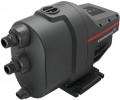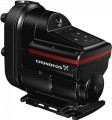Maximum performance
The maximum volume of water that the device can pump in a certain amount of time. It is one of the key specs of any pump because characterizes the volume of water with which the device can work. At the same time, it does not always make sense to pursue maximum performance — after all, it significantly affects the dimensions and weight of the unit.
Some formulas allow you to derive optimal performance values for different situations. So, if the pump is designed to supply water to water intake points, its minimum required performance should not be lower than the highest total flow rate; if desired, a margin of 20-30% can be added to this value. And for sewer models (see "Suitable for"), everything will depend on the volume of wastewater. More detailed recommendations for choosing a pump depending on performance can be found in special sources.
Max. pressure
The highest pressure that the pump is capable of creating during operation. This parameter is directly related to the maximum head (see above); however, it is less obvious, and therefore, it is indicated rarely.
Suction type
The main division in this parameter is related to whether the pump can remove air from the suction line. This, in turn, determines the features of starting the unit.
— Self-priming. Self-priming pumps include all pumps that do not require the complete absence of air in the suction line at startup — it is enough that the pump itself is filled with water. Accordingly, such models are less demanding and normally tolerate air entering the line. However, this requires a reliable design that can normally withstand water hammer, which accordingly affects the cost of the unit.
— Priming. Pumps with this device can only work normally when both the unit body and the suction line are filled with water. If air enters the line, it must be removed or the pump will not be able to start normally. Such models are not as convenient as self-priming ones; at the same time, they are noticeably cheaper, and with the normal quality of the water supply system, there is practically no significant difference between the two varieties.
Dry run protection
A system that protects the unit from running without water.
The dry running mode is abnormal for any pump: at best, the mechanism of the unit in this mode experiences increased loads, and at worst, the device may fail and even a serious accident. This feature allows you to prevent such consequences. The specific method of protection against dry running may be different; one of the most popular options is a float switch (see below). However, in addition, flow sensors, pressure or level switches can be used. These details depend both on the general type of pump and on the specific model; they should be specified separately in each case.
Suction system
— Single-stage. Suction system with one impeller or similar element. Although such a design loses to a multistage one in terms of efficiency and power, at the same time, its characteristics are quite enough for most tasks; while single-stage pumps are simpler and cheaper. Due to all this, this option is used in most modern units.
— Multistage. This suction system consists of several impellers (or other similar parts that directly provide suction). Such pumps are significantly superior to single-stage ones, they provide powerful pressure and are less sensitive to impurities. At the same time, in fact, all these advantages are needed relatively rarely, and multistage systems are quite expensive. Because of this, they are used in a relatively small number of pumps — they are mainly powerful models designed for situations where one suction stage is not enough.
Maximum power
Rated power of the pump motor. The more powerful the engine, the higher the performance of the unit, usually, the greater the pressure, suction height, etc. Of course, these parameters largely depend on other features (primarily the pump type, see above); but models similar in design can be compared in terms of power.
Note that high power, usually, increases the size, weight and cost of the pump, and also implies high costs of electricity or fuel (see "Power source"). Therefore, it is worth choosing a pump according to this parameter taking into account the specific situation; more detailed recommendations can be found in special sources.

